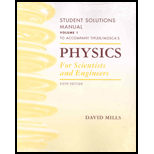
Concept explainers
(a)
Wave function of two waves.
(a)
Explanation of Solution
Given:
The wave function of standing wave is given as
Introduction:
The superimposed traveling waves have same wave number and same angular frequency. However, the amplitude of superimposed waves is equal and half the amplitude of the standing wave.
Write expression for the wave function for the wave traveling in positive x-direction.
Write expression for the wave function for the wave traveling in negative x-direction.
Conclusion:
Thus, the wave function for superimposed waves in positive and negative x-direction is given above.
(b)
The distance between nodes of the standing wave.
(b)
Explanation of Solution
Given:
The wave function of standing wave is given as
Formula used:
Write expression for wave number.
Rearrange above expression for
Write expression for distance between adjacent nodes.
Substitute
Calculation:
Substitute
Conclusion:
Thus, the distance between two waves is
(c)
The maximum speed of the rope at
(c)
Explanation of Solution
Given:
The wave function of standing wave is given as
Formula used:
Write expression for standing wave.
Calculation:
Differentiate equation (1) with respect to
Substitute
Substitute
Conclusion:
Thus, the maximum speed of the wave at
(d)
The maximum acceleration of the rope at
(d)
Explanation of Solution
Given:
The wave function of standing wave is given as
Formula used:
Write expression for standing wave.
Calculation:
Differentiate equation (1) with respect to
Differentiate above expression with respect to
Substitute
Conclusion:
Thus, maximum acceleration at
Want to see more full solutions like this?
Chapter 16 Solutions
Physics For Scientists And Engineers Student Solutions Manual, Vol. 1
- A string with a mass of 0.30 kg has a length of 4.00 m. If the tension in the string is 50.00 N, and a sinusoidal wave with an amplitude of 2.00 cm is induced on the string, what must the frequency be for an average power of 100.00 W?arrow_forwardConsider two wave functions that differ only by a phase shift, y1(x,t)=Acos(kxt) and y2(x,t)=Acos(kxt+) . Use the trigonometric cosu+cosv=2cos(uv2)cos(u+v2) and cos()=cos() to find a wave equation for the wave resulting from the superposition of the two waves. Does the resulting wave function come as a surprise to you?arrow_forwardTwo sinusoidal waves are moving through a medium in the same direction, both having amplitudes of 3.00 cm, a wavelength of 5.20 m, and a period of 6.52 s, but one has a phase shift of an angle . What is the phase shift if the resultant wave has an amplitude of 5.00 cm? [Hint: Use the trig identity sinu+sinv=2sin(u+v2)cos(uv2)arrow_forward
- Consider two sinusoidal waves traveling along a string, modeled as y1(x,t)=0.3msin(4m1x+3s1t) and y2(x,t)=0.6msin(8m1x6s1t) . What is the height of the resultant wave formed by the interference of the two waves at the position x=0.5 m at time t=0.2 s?arrow_forwardTwo sinusoidal waves are moving through a medium in the positive x-direction, both having amplitudes of 7.00 cm, a wave number of k=3.00 m-1, an angular frequency of =2.50 s-1, and a period of 6.00 s, but one has a phase shift of an angle =12 rad. What is the height of the resultant wave at a time t=2.00 s and a position x=0.53 m?arrow_forwardConsider two sinusoidal sine waves traveling along a string, modeled as y1(x,t)=0.3msin(4m1x+3s1t+3) and y2(x,t)=0.6msin(8m1x6s1t) . What is the height of the resultant wave formed by the interference of the two waves at the position x=1.0 m at time t=3.0 s?arrow_forward
- Consider two wave functions y(x,t)=0.30cmsin(3m1x4s1t) and y(x,t)=0.30cmsin(3m1x+4s1t) . Write a wave function for the resulting standing wave.arrow_forwardA sound wave in air has a pressure amplitude equal to 4.00 103 Pa. Calculate the displacement amplitude of the wave at a frequency of 10.0 kHz.arrow_forwardA taut rope has a mass of 0.180 kg and a length of 3.60 m. What power must be supplied to the rope so as to generate sinusoidal waves having an amplitude of 0.100 m and a wavelength of 0.500 m and traveling with a speed of 30.0 m/s?arrow_forward
- Two strings are attached between two poles separated by a distance of 2.00 meters as shown in the preceding figure, both strings have a linear density of 1=0.0025 kg/m, the tension in string 1 is 600.00 N and the tension in string 2 is 700.00 N. Transverse wave pulses are generated simultaneously at opposite ends of the strings. How much time passes before the pulses pass one another?arrow_forwardA wave on a string is driven by a string vibrator, which oscillates at a frequency of 100.00 Hz and an amplitude of 1.00 cm. The string vibrator operates at a voltage of 12.00 V and a current of 0.20 A. The power consumed by the string vibrator is P=IV . Assume that the string vibrator is 90% efficient at converting electrical energy into the energy associated with the vibrations of the string. The string is 3.00 m long, and is under a tension of 60.00 N. What is the linear mass density of the string?arrow_forwardTwo waves are generated on a string of length3.0 m to produce a three-loop standing wave with an amplitude of1.0 cm. The wave speed is 100 m/s. Let the equation for one of thewaves be of the form y(x, t)=ym sin(kx+vt). In the equation for theother wave, what are (a) ym, (b) k, (c) v, and (d) the sign in front of v?arrow_forward
 Physics for Scientists and Engineers: Foundations...PhysicsISBN:9781133939146Author:Katz, Debora M.Publisher:Cengage Learning
Physics for Scientists and Engineers: Foundations...PhysicsISBN:9781133939146Author:Katz, Debora M.Publisher:Cengage Learning Principles of Physics: A Calculus-Based TextPhysicsISBN:9781133104261Author:Raymond A. Serway, John W. JewettPublisher:Cengage Learning
Principles of Physics: A Calculus-Based TextPhysicsISBN:9781133104261Author:Raymond A. Serway, John W. JewettPublisher:Cengage Learning University Physics Volume 1PhysicsISBN:9781938168277Author:William Moebs, Samuel J. Ling, Jeff SannyPublisher:OpenStax - Rice University
University Physics Volume 1PhysicsISBN:9781938168277Author:William Moebs, Samuel J. Ling, Jeff SannyPublisher:OpenStax - Rice University Classical Dynamics of Particles and SystemsPhysicsISBN:9780534408961Author:Stephen T. Thornton, Jerry B. MarionPublisher:Cengage Learning
Classical Dynamics of Particles and SystemsPhysicsISBN:9780534408961Author:Stephen T. Thornton, Jerry B. MarionPublisher:Cengage Learning



